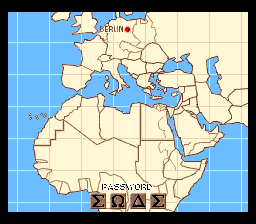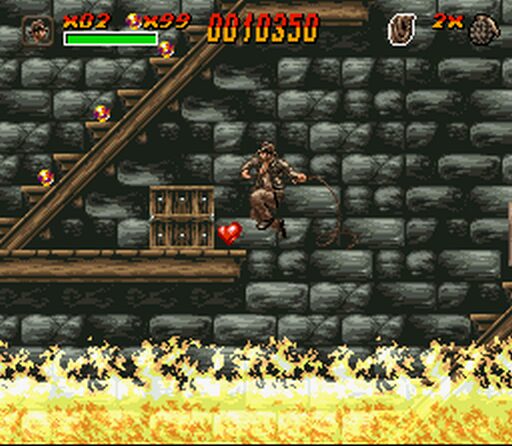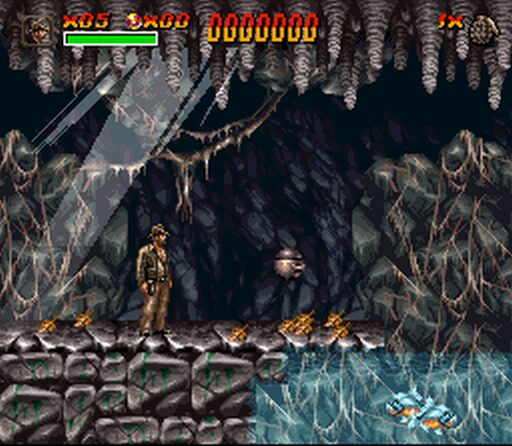Retro Replay Review
Gameplay
Indiana Jones’ Greatest Adventures borrows the fast-paced, run-and-gun platforming style popularized by Super Star Wars on the SNES, and it channels it into three classic Indy films. From the first frame, players command Indy’s trademark whip to disarm foes, navigate treacherous ledges, and swing across chasms. Alongside the whip, you’ll regularly swap between pistols, grenades, and bare-knuckle brawling, giving a satisfying variety of combat options as you progress through each level.
(HEY YOU!! We hope you enjoy! We try not to run ads. So basically, this is a very expensive hobby running this site. Please consider joining us for updates, forums, and more. Network w/ us to make some cash or friends while retro gaming, and you can win some free retro games for posting. Okay, carry on 👍)
Each stage is loosely based on iconic moments from Raiders of the Lost Ark, Temple of Doom, and Last Crusade, but the design leans heavily into tight, skill-based sequences rather than open exploration. You’ll leap over spike pits, dodge rolling boulders, and time your attacks carefully to dispatch cultists, spiders, and Nazi soldiers alike. The learning curve is gentle at first but ramps up when you hit the Mine Cart chase or the tank battle in the Last Crusade segment, rewarding precise timing and pattern recognition.
Special levels such as the runway boulder escape, the frenetic mine-cart roller coaster, and the biplane dogfight add welcome variety, breaking up platform sections with memorable action set pieces. These stages are more than mere gimmicks—they challenge your reflexes and keep the pacing brisk. While some may find a handful of sections punishingly precise, the overall flow ensures that each replay feels like a chance to sharpen your skills and uncover hidden areas laden with extra lives.
Graphics
The pixel art in Indiana Jones’ Greatest Adventures is vibrant and detailed, capturing the distinct look of each film era. Character sprites are bold and easily readable, with Indy sporting his fedora and leather jacket down to the last pixel. Backgrounds are richly layered, evoking dusty caverns, dank temples, and 1930s European locales with convincing color palettes that push the SNES hardware to good effect.
Cutscenes employ digitized speech snippets and still images lifted from promotional materials, lending an almost immersive cinematic feel between levels. While the image captures are static, they serve as effective narrative bookmarks—reminding players which movie chapter they’re in and offering brief respites from the action. Sound effects like whip cracks, gunshots, and rolling boulders are punchy, adding further weight to your onscreen exploits.
John Williams’ iconic themes weave in and out of boss encounters and stage transitions, albeit in abbreviated 16-bit form. The main melody from Raiders of the Lost Ark heralds key moments with stirring authority, while the Temple of Doom and Last Crusade motifs punctuate their respective segments. Though the SNES sound chip can’t replicate Williams’ full orchestral sweep, the selected arrangements are instantly recognizable and add immeasurably to the game’s atmosphere.
Story
Rather than crafting an original plot, the game faithfully adapts the events of the first three Indy movies, chapter by chapter. You start in the jungles of Peru, chasing after the Ark of the Covenant, before plunging into the dark heart of Pankot Palace in India, and finally racing across Europe to recover the Holy Grail. Each film’s key sequences are distilled into bite-sized levels, ensuring the overall narrative remains coherent despite the game’s platformer roots.
Dialogue is almost non-existent outside of brief cutscene captions and the occasional spoken word sample, so the storytelling relies heavily on environmental cues and level structure. This minimalist approach works in favor of the gameplay, preventing long-winded exposition from stalling the momentum. Fans of the films will appreciate the nods to famous set pieces and villains, even if newcomers might miss some narrative context.
By weaving the three adventures into one seamless cartridge, the game offers a satisfying sense of progression. You witness Indy’s evolution from a globe-trotting archaeologist to a seasoned hero confronting supernatural threats and Nazi commanders. While the story is nothing groundbreaking for hardcore gamers, its tight focus on action and iconic moments makes it a perfect fit for retro enthusiasts seeking nostalgic thrills.
Overall Experience
Indiana Jones’ Greatest Adventures stands out as one of the more polished licensed titles on the SNES. Its blend of accessible yet challenging platforming, coupled with faithful film recreations, delivers a consistently enjoyable ride. Whether you’re ducking rolling boulders in Raiders or careening through a mine shaft in Temple of Doom, each level feels thoughtfully designed to evoke cinematic excitement.
The game’s difficulty curve strikes a reasonable balance, offering just enough challenge to keep seasoned players engaged without overwhelming newcomers. Checkpoint placement is generous, and the lives system encourages you to master each sequence rather than brute-force progress. Special stages and boss fights break up any potential monotony, ensuring the pacing remains dynamic from start to finish.
For collectors and fans of classic platformers, Indiana Jones’ Greatest Adventures is a must-play on the SNES. It may not reinvent the wheel, but its faithful adaptation of three beloved films, memorable stage designs, and spirited presentation combine into an experience that still holds up decades after its release. If you crave arcade-style thrills wrapped in cinematic flair, Indy’s Greatest Adventures delivers on every front.
 Retro Replay Retro Replay gaming reviews, news, emulation, geek stuff and more!
Retro Replay Retro Replay gaming reviews, news, emulation, geek stuff and more!









Reviews
There are no reviews yet.